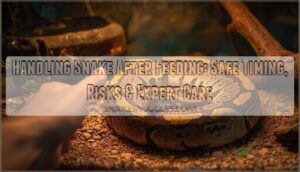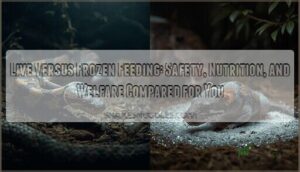This site is supported by our readers. We may earn a commission, at no cost to you, if you purchase through links.
 Your snake’s feeding frequency depends entirely on age.
Your snake’s feeding frequency depends entirely on age.
Hatchlings need meals every 5-7 days since they’re growing fast and burning energy like tiny furnaces.
Juveniles can wait 7-10 days between feedings as their growth rate slows down.
Adult snakes only need food every 10-14 days because their metabolism runs much slower.
Think of it like this: baby snakes are sports cars that need frequent fill-ups, while adults are fuel-efficient hybrids.
The key is watching your snake’s body condition rather than following rigid schedules.
A chubby snake needs less frequent meals, while a skinny one might need more.
Getting the timing right involves understanding how temperature, prey size, and your snake’s natural behavior patterns all work together.
Table Of Contents
- Key Takeaways
- Snake Feeding Basics
- Feeding Frequency Guidelines
- Age Based Feeding Schedules
- Species Specific Feeding
- Prey Size and Type
- Feeding Environment Factors
- Health and Nutrition Considerations
- Feeding Schedule Adjustments
- Seasonal Feeding Variations
- Monitoring Feeding Success
- Frequently Asked Questions (FAQs)
- Conclusion
Key Takeaways
- Your snake’s age determines feeding frequency – hatchlings need meals every 5-7 days, juveniles every 7-10 days, and adults only every 10-14 days as their metabolism slows with maturity.
- You should prioritize your snake’s body condition over rigid schedules – a chubby snake needs less frequent meals while a skinny one requires more, regardless of age guidelines.
- Temperature directly affects how often you’ll feed your snake since warmer environments boost metabolism and increase appetite, while cooler conditions slow digestion and reduce feeding frequency.
- You’ll need to adjust feeding schedules seasonally as snakes naturally eat more during spring and summer months but may refuse food entirely during winter brumation periods.
Snake Feeding Basics
Understanding your snake’s basic feeding needs sets the foundation for proper care and healthy growth.
As carnivores, snakes require whole prey animals to meet their complete nutritional requirements, and you’ll need to follow specific safety practices to protect both you and your pet, ensuring proper care.
Carnivorous Diet Needs
Your snake needs meat, and only meat, to thrive. These obligate carnivores have digestive systems built for processing whole prey, not plant matter or processed foods.
Snakes are pure carnivores – whole prey delivers complete nutrition that meat scraps simply cannot match.
In the wild, snakes hunt small mammals, birds, and reptiles. Captive prey like frozen mice provides complete nutrition that meat scraps can’t match.
Their feeding behaviors center around constriction and swallowing prey whole.
Whole Prey Importance
Feeding whole prey guarantees your snake receives complete nutrition that processed foods can’t match.
Your pet needs the entire animal—bones, organs, and muscle—to thrive and avoid nutritional gaps.
- Complete Nutrition: Whole prey delivers balanced vitamins, minerals, and proteins
- Bone Consumption: Calcium from bones supports proper growth and shell formation
- Organ Benefits: Liver and kidneys provide essential vitamins A and B complex
- Digestive Health: Natural prey structure promotes healthy gut function
- Avoiding Deficiencies: Prevents common nutritional gaps from incomplete diets
Feeding Safety Precautions
With proper precautions, you’ll prevent injuries and contamination during feeding time.
Always use feeding tongs when handling prekilled, frozenthawed prey to avoid accidental bites. Consider specialized feeding equipment for enhanced safety.
Store frozen prey safely until thawing practices begin – thaw overnight in your refrigerator, then warm in water. Never refreeze uneaten meals due to refeeding risks from bacterial growth and dangerous contaminants.
Feeding Frequency Guidelines
Understanding your snake’s hunger schedule requires recognizing that these cold-blooded creatures operate on a different timeline than warm-blooded pets.
Their snake feeding frequency depends on several key factors that you’ll need to master for successful reptile care.
Optimal intervals vary dramatically based on your snake’s age, species, and individual metabolism.
Young snakes burn through calories faster than their adult counterparts, requiring more frequent meals to fuel rapid growth.
Your juvenile snake feeding schedule will be much tighter than adult snake feeding routines.
Temperature plays a vital role in your snake’s appetite.
Warmer environments boost metabolism, while cooler conditions slow digestion.
Individual variation means some snakes eat like clockwork while others prefer irregular patterns.
Watch for overfeeding signs like rapid weight gain or reluctance to eat.
Underfeeding risks include stunted growth and weakened immune systems.
During winter months, brumation impact may reduce appetite substantially, making your carefully planned snake feeding schedule temporarily irrelevant.
Adjust your snake age diet expectations accordingly.
To guarantee safety, it’s best to use frozen-thawed prey.
Age Based Feeding Schedules
Your snake’s age determines how often it needs to eat, with younger snakes requiring more frequent meals than adults.
Understanding these age-based feeding schedules helps you provide proper nutrition while avoiding overfeeding or underfeeding your pet, which is crucial for the snake’s overall health and well-being.
Hatchling Feeding Frequency
New hatchlings won’t eat right after hatching – they’ll wait until their first shed, usually 7-14 days later. Your baby snake diet relies on yolk reserves during this time, so don’t panic if they refuse initial meals.
To properly care for your snake, research snake care guidelines for specific advice on feeding and housing.
- Feed every 5-7 days once they start eating
- Prey size should match 1-1.5 times their midbody width
- Growth spurts happen fast, so monitor weight monthly
- Brumation effects are minimal in young snakes
Juvenile Feeding Frequency
During their rapid growth phase, juvenile snakes need consistent fuel for their developing bodies.
Feed them every 7-10 days with appropriately sized prey. Growth rates demand regular feeding cycles, while their faster metabolism requires careful meal sizing to meet nutrient needs.
Monitor digestion times between feedings—juvenile snakes process food quicker than adults, making consistent snake feeding frequency essential for healthy development.
Understanding snake feeding practices is essential for providing the right care, and recognizing the importance of rapid growth phase and healthy development can significantly impact the snake’s well-being.
Subadult Feeding Frequency
As your subadult snake matures, their feeding schedule shifts to accommodate slower growth rates and longer digestion time.
These developing reptiles need consistent nutrition but less frequent meals than juveniles.
- Feed every 10-21 days depending on species and size (corn snakes every 10-12 days, ball pythons every 14-21 days)
- Monitor weight regularly to guarantee steady growth without excessive fat accumulation
- Adjust meal frequency based on body condition and activity levels
- Use prey sized 7-10% of body weight for ideal subadult nutrition
- Track feeding responses to identify patterns and health changes early
Adult Feeding Frequency
Adult snakes need meals every 14-21 days, though individual snake metabolism varies.
Their slower digestion rates mean longer feeding cycles compared to younger snakes.
Monitor your adult snake’s weight and adjust meal scheduling accordingly, as overfeeding becomes a bigger concern as snake feeding frequency decreases with age.
So watch for obesity signs.
Species Specific Feeding
Different snake species have unique feeding requirements that affect how often you’ll need to offer meals.
While corn snakes and ball pythons share similar carnivorous needs, their metabolic rates and growth patterns create distinct feeding schedules you’ll want to follow.
Corn Snake Feeding
Corn snakes thrive when you master their specific feeding requirements and nutrition needs.
These adaptable constrictors require consistent snake feeding schedules that match their growth stage and metabolic demands.
Your corn snake feeding frequency depends on four key factors:
- Age and size – Hatchlings need food every 5-7 days, while adults eat every 14-21 days
- Prey selection – Choose mice that match your snake’s mid-body width using proper feeding tools
- Feeding techniques – Use tongs and feed in the enclosure to reduce stress
- Digestion process – Allow 48-72 hours between handling after meals
Following these snake feeding guidelines guarantees superior snake nutrition throughout your pet’s life.
Ball Python Feeding
Ball pythons require different feeding charts than corn snakes due to their slower metabolism.
Your python nutrition needs change dramatically with age – hatchlings need meals every 5-7 days, while adults can wait 21-50 days between feedings.
These meal schedules support proper snake growth without overfeeding.
Following a structured python feeding schedule prevents obesity and guarantees healthy development throughout your snake’s life.
Prey Size and Type
You’ll need to match prey size carefully to your snake’s body dimensions and age for safe, healthy feeding.
The right prey type and size prevents regurgitation, guarantees proper nutrition, and supports healthy growth throughout your snake’s development.
Prey Size Guidelines
Proper prey measurement prevents digestive problems and guarantees your snake’s health.
Choose prey that’s 1.5 times your snake’s thickest body section, never exceeding 10% of its total weight.
These size guidelines create the perfect feeding ratio for safe digestion.
Using feeding tongs helps you assess prey limits accurately while maintaining your snake feeding schedule.
Understanding prey size guidelines is vital for preventing feeding disasters and promoting healthy growth.
Prey Type Variations
Beyond basic rodent types like fuzzy mice, you can offer prey options including quail, gerbil diet alternatives, and various rodent types to enhance your snake’s nutrition.
Different prey provides essential nutrients – quail feeding supplies unique proteins while gerbils offer dietary variety.
This approach supports ideal snake feeding frequency by age, ensuring your snake feeding schedule includes diverse prey type variations that match your snake’s developmental needs and preferences.
Understanding snake food options online is vital for providing a balanced diet with the right prey options and snake feeding schedule to ensure your pet’s health.
Feeding Environment Factors
Your snake’s environment directly affects how often it needs to eat, with temperature being the most critical factor.
Warmer enclosures speed up digestion and increase appetite, while cooler temperatures slow metabolism and reduce feeding frequency, making environment a crucial aspect of their care.
Temperature Effects
Temperature acts like your snake’s internal thermostat, directly controlling how often they’ll want to eat.
Your snake’s appetite runs on temperature – warmer means hungrier, cooler means less frequent feeding.
When temperatures hit that sweet spot of 75-85°F, your snake’s metabolic rate kicks into high gear, speeding up digestion rates and creating natural heat cycles.
Temperature gradients let them find their perfect thermal regulation zone, giving their metabolism the boost needed for regular feeding schedules.
Maintaining proper temperature is vital, and using proper heat lamp systems can help achieve this balance, ensuring a healthy thermal regulation and supporting the snake’s overall digestion rates.
Humidity Effects
Humidity levels directly impact your snake’s respiratory health and feeding patterns.
Low humidity can cause shedding issues and skin problems, making snakes reluctant to eat.
Maintain proper air quality with adequate humidity using dechlorinated water bowls.
Monitor your snake feeding schedule closely during dry periods, as dehydration affects appetite and digestion substantially, and ensure to provide a suitable environment for your snake’s overall health.
Health and Nutrition Considerations
Your snake’s nutritional needs go beyond just feeding frequency and directly impact their overall health and longevity.
Proper hydration and balanced nutrition form the foundation of a healthy feeding program that supports growth, immune function, and reproductive health, which are all crucial for a snake’s overall longevity.
Nutritional Needs
Your snake’s nutritional needs revolve around complete protein sources from whole prey animals.
Mice and rats provide essential amino acids, while occasional variety like quail offers different vitamin needs and mineral supplements.
Monitor your snake’s caloric intake to maintain proper nutrient balance.
Age affects snake feeding frequency, with younger snakes requiring more frequent meals for ideal snake digestive health and meeting snake nutritional requirements effectively.
Hydration Requirements
Water intake keeps your snake’s fluid balance in check, preventing dehydration that can disrupt snake feeding frequency and overall health.
Provide fresh, dechlorinated water in a large bowl at all times.
Watch for dehydration signs like wrinkled skin or sunken eyes, and ensure proper humidity levels help maintain their drinking habits and support healthy hydration naturally, as most snakes don’t drink often, but dechlorinated water and healthy hydration are crucial.
Feeding Schedule Adjustments
You’ll need to adjust your snake’s feeding schedule based on its weight and activity level rather than following a rigid timetable.
Regular weight monitoring helps you determine if your snake is growing properly or if you need to increase or decrease feeding frequency.
Weight Monitoring
Regular weight monitoring keeps your snake healthy and prevents feeding mistakes. You’ll catch problems early when you track body mass consistently using a digital scale.
- Weekly weigh-ins reveal subtle changes before they become serious health issues
- Growth charts help you spot when your snake isn’t thriving like it should
- Scale accuracy matters – invest in a quality digital scale for reliable readings
- Body condition checks show if your snake is too thin, perfect, or getting chunky
- Weight loss patterns signal illness, stress, or feeding schedule problems that need attention
Activity Level Considerations
Active snakes burn more calories and need frequent meals.
Young, energetic snakes require food every 5-7 days, while lazy adults eat every 14-21 days.
Watch your snake’s movement patterns to adjust feeding schedules.
Understanding proper snake feeding schedules is essential for maintaining a healthy pet.
| Activity Level | Metabolic Rates | Feeding Frequency |
|---|---|---|
| High (young/active) | Fast metabolism | Every 5-7 days |
| Moderate (subadult) | Medium metabolism | Every 7-14 days |
| Low (adult/sedentary) | Slow metabolism | Every 14-21 days |
The metabolic rates and feeding frequency are crucial factors to consider when determining the feeding schedule for your snake, as they directly impact its overall well-being and require careful observation of its activity level.
Seasonal Feeding Variations
Your snake’s appetite changes with the seasons just like wild snakes respond to temperature shifts and daylight patterns.
Understanding these natural cycles helps you adjust feeding schedules to match your pet’s changing metabolic needs throughout the year, which is crucial for their health and wellbeing, especially when considering their natural cycles.
Spring and Summer Feeding
Warmer temperatures trigger your snake’s natural feeding peaks during spring and summer months.
Heat cycles boost metabolism, making your pet more active and hungry. You’ll notice increased appetite as warmth effects kick in – this means adjusting your snake feeding frequency upward.
Summer diet demands often require feeding every 5-7 days for young snakes, compared to winter schedules. These seasonal adjustments align with your snake’s biological rhythms and feeding habits.
Understanding the proper snake feeding schedule is essential for maintaining a healthy pet, and recognizing the impact of warmer temperatures and seasonal adjustments is crucial.
Fall and Winter Feeding
When cold weather arrives, your snake’s metabolic rate drops substantially, triggering natural seasonal adjustments in feeding cycles.
During winter months, many snakes enter brumation, reducing or completely stopping food intake.
Temperature regulation becomes vital as sluggish digestion makes feeding dangerous, and you can expect your snake to refuse meals for weeks, requiring careful brumation care and modified winter diet schedules until spring returns.
Monitoring Feeding Success
Monitoring your snake’s feeding success helps you spot potential health issues early and guarantees proper growth throughout their life.
You’ll need to track weight gain patterns and know how to address feeding refusals when they occur.
Weight Gain Indicators
Monitoring your snake’s body mass reveals feeding success through steady scale weight increases.
Healthy snakes show consistent growth rates that match their growth stage requirements.
You’ll notice fat reserves developing along the spine and sides when nutrition levels are adequate.
Body weight should increase gradually between feedings, with minor weight fluctuations being normal during the snake digestive process.
The overall health and growth of the snake are indicated by consistent growth rates and gradual weight increases.
Feeding Refusal Solutions
When your snake won’t eat, don’t panic. Feeding refusal often stems from environmental issues or natural cycles.
Here’s how to troubleshoot snake feeding habits:
- Check temperatures – Basking spots below 85°F suppress appetite and disrupt feeding triggers
- Try prey scenting – Rub prey with chick fluff or fish oil for appetite stimulation
- Adjust timing – Offer food at dusk when nocturnal hunting instincts peak
- Wait between attempts – Space offerings weekly to avoid reinforcing refusal reasons and prevent regurgitation prevention issues
Frequently Asked Questions (FAQs)
How do you know if you’re feeding your snake enough?
Regular weight monitoring tells you if you’re feeding correctly.
A healthy snake maintains steady body condition—not too thin or too fat.
Check that they’re growing appropriately for their age and eating consistently.
Can snakes eat during shedding periods?
Most snakes refuse food during shedding because their vision becomes cloudy and they feel vulnerable. It’s perfectly normal behavior – they’ll resume eating once they’ve completed their shed cycle.
How long after regurgitation before refeeding?
Patience is key—wait at least two weeks before offering food again. This gives your snake’s digestive system time to recover and prevents another regurgitation episode from happening too soon.
What if my snake refuses food?
Check prey size, enclosure temperature, and shedding cycles if your snake refuses food. Wait two weeks after regurgitation before refeeding. Try scenting techniques or different rodent types to stimulate appetite.
Should I feed sick or injured snakes?
Ah, the age-old question of playing doctor to your scaly patient.
Don’t feed sick or injured snakes – their bodies need energy for healing, not digestion.
Consult a reptile veterinarian first for proper treatment.
Can overfeeding cause permanent health damage?
Yes, overfeeding can cause permanent damage.
Obesity strains organs, shortens lifespan, and creates reproductive problems.
You’ll see fatty liver disease, heart issues, and difficulty shedding that won’t reverse easily once established, leading to severe health complications with permanent damage.
Conclusion
Mastering snake feeding frequency by age is like learning to read your pet’s unique biological clock.
You’ve discovered that hatchlings need weekly meals, juveniles require feeding every 7-10 days, and adults thrive on 10-14 day schedules.
Remember that your snake’s body condition matters more than rigid timelines.
Temperature, prey size, and seasonal changes all influence appetite.
By monitoring weight and adjusting accordingly, you’ll keep your serpent healthy and content throughout every life stage, ensuring a long and healthy life.
- https://onlinelibrary.wiley.com/doi/10.1111/j.1439-0396.2010.01011.x
- https://scripts.affiliatefuture.com/AFShortUrl.aspx?id=15411
- https://www.exoticdirect.co.uk/news/feeding-corn-snakes
- https://www.anapsid.org/hatchlin.html
- https://www.evolutionreptiles.co.uk/blog/feeding-corn-snakes-preventing-obesity-and-promote-healthy-nutrition/

















